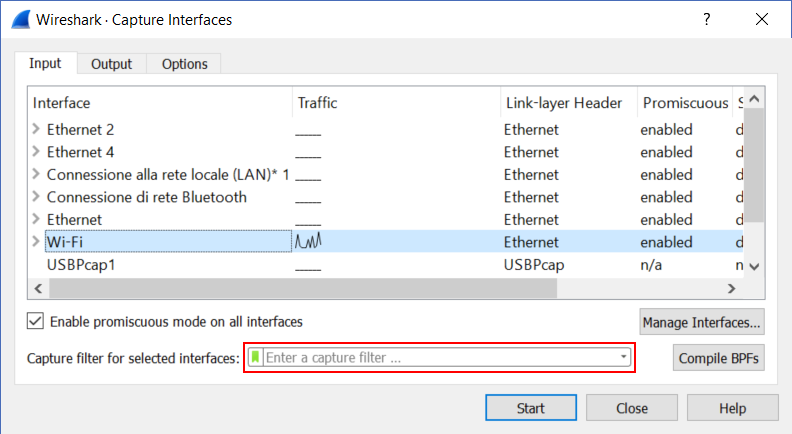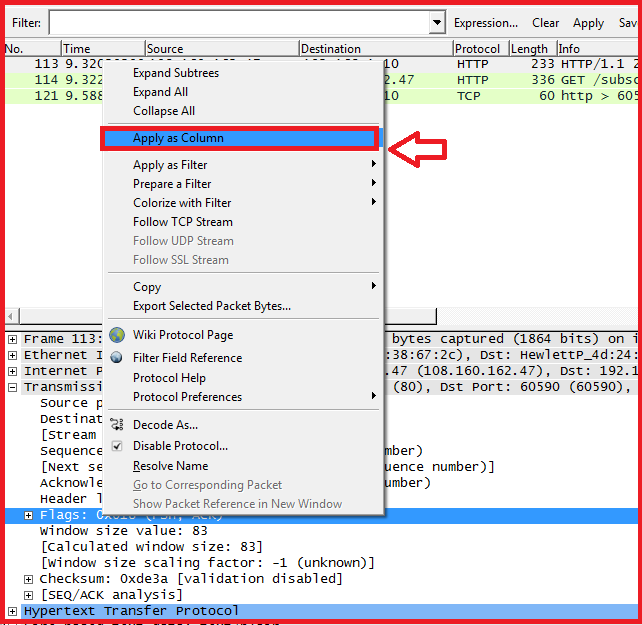

- #WIRESHARK USE CAPTURE FILTER HOW TO#
- #WIRESHARK USE CAPTURE FILTER PROFESSIONAL#
- #WIRESHARK USE CAPTURE FILTER MAC#
- #WIRESHARK USE CAPTURE FILTER WINDOWS#
With the option “ip” selected, all Internet Protocol traffic is shown, which is fine in the 99% of cases.
#WIRESHARK USE CAPTURE FILTER MAC#
Then run the arp command:Ĭlick apply, and you will see only the traffic that is coming from, or going to, that IP or MAC address. To get the mac-address of the target on the other end of the connection, first issue a ping command to the hostname or URL of the target computer to learn its IP address. You could filter for mac-address to be sure to pinpoint the right client. Now suppose you want to see all the traffic coming in and out of one specific computers. You can also isolate only requests toward a specific site – Facebook, for example – to see which IP addresses are requesting it, by placing the filter contains facebook in the Filter field.
#WIRESHARK USE CAPTURE FILTER WINDOWS#
To do that, choose an http request in the main windows where you see all the packets, right-click on it, and choose the option “Follow TCP Stream.” Wireshark will open a new window containing the reconstruction of that entire HTTP session in chronological order. Perhaps you are interested in following a particular kind of information, or a particular user. Each web page that any users on your network visits will generate this kind of traffic for you to catch – which may be a lot of information.

You can click on Edit -> Preferences -> Protocols -> HTTP and verify that “Uncompress entity bodies” is checked.ĭuring the capture, set a filter to show only HTTP traffic by entering http. Today, most HTTP traffic is compressed to speed up the exchange of information, so by default Wireshark decompresses the body part of HTTP packets. As before, start Wireshark and start capturing the traffic from the interface that goes out. Here’s another classic example – an HTTP session.
#WIRESHARK USE CAPTURE FILTER HOW TO#
In this article we’ll see how apply BPF filters to wireshark to show the details of an HTTP session, an e-mail session and how to monitor who is visiting a certain site from our local network.įinally I will make a summary of the most useful filters to use with Wireshark. To display traffic from multiple IP addresses: ip.addr = 10.0.6.187 or ip.addr = 10.0.6.This is an article of mine, first published on Wazi To display source and destination traffic between two specific IP addresses: ip.addr = 10.0.6.101 & ip.addr = 10.0.6.187 To display traffic from a specific source or destination IP address: ip.src = 10.0.6.187 ip.dst = 10.0.6.187 To display traffic from a specific IP address: ip.addr = 10.0.6.187

Once you start capturing traffic, you can then refine your capture results by using a display filter. To capture various types of IPv6 traffic: ip6 dst host ff02::1 To capture traffic from a specific URL or host: host To exclude a specific type of traffic: not port 23 not arp To capture traffic from a specific port or range of ports: port 23 portrange 1-1024 tcp portrange 1-1024 UDP port 167 UDP portrange 1-1000

To capture traffic from a specific host: host 10.0.6.187 Capture FiltersĬapture filters allow you to capture specific types of traffic, this prevents the capture of packets you don’t want, thus not wasting valuable processing power and hard drive space. This workshop is an introduction to network conversation statistics, threat hunting, and carving documents from. At a minimum, you should understand capture filters, display filters, profiles, and how to filter for different services as well as identifying IPv6 traffic.
#WIRESHARK USE CAPTURE FILTER PROFESSIONAL#
Wireshark is a tool every security professional should be comfortable with. The most popular packet analyzer is Wireshark, so let’s take a look at how it works and how to use it. Packet analyzers can take a file of captured data (known as a pcap file) and examine it in various ways to tell us more about the traffic between different machines on a network. One of our primary tools for passive/active information gathering is a program called a protocol analyzer or packet analyzer.


 0 kommentar(er)
0 kommentar(er)
